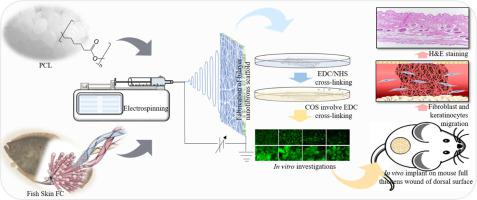Biomaterials Advances ( IF 5.5 ) Pub Date : 2021-01-08 , DOI: 10.1016/j.msec.2021.111871 Pathum Chandika , Gun-Woo Oh , Seong-Yeong Heo , Se-Chang Kim , Tae-Hee Kim , Min-Sung Kim , Won-Kyo Jung

|
The development of tissue-engineered biodegradable artificial tissue substitutes with extracellular matrix-mimicking properties that govern the interaction between the material and biological environment is of great interest in wound-healing applications. In the present study, novel bilayer nanofibrous scaffolds composed of fish collagen (FC) and poly(ε-caprolactone) (PCL) were fabricated using electrospinning, with the covalent attachment of chitooligosaccharides (COS) via carbodiimide chemistry. The architecture and fiber diameter of the non-cross-linked nanofibrous scaffolds remained consistent irrespective of the polymer ratio under different electrospinning conditions, but the fiber diameter changed after cross-linking in association with the FC content. Fourier-transform infrared spectroscopy analysis indicated that the blend of biomaterials was homogenous, with an increase in COS levels with increasing FC content in the nanofibrous scaffolds. Based on cytocompatibility analysis (i.e., the cellular response to the nanofibrous scaffolds and their interaction), the nanofibrous scaffolds with high FC content were functionally active in response to normal human dermal fibroblast‑neonatal (NHDF-neo) and HaCaT keratinocyte cells, leading to the generation of a very effective tissue-engineered implant for full-thickness wound-healing applications. In addition to these empirical results, an assessment of the hydrophilicity, swelling, and mechanical integrity of the proposed COS-containing FC-rich FC/PCL (FCP) nanofibrous scaffolds confirmed that they have significant potential for use as tissue-engineered skin implants for rapid skin regeneration.
中文翻译:

电纺多孔双层纳米纤维鱼胶原蛋白/ PCL生物复合支架,共价交联壳寡糖,可用于全层伤口愈合
具有细胞外基质模拟特性的组织工程化可生物降解的人造组织替代物的发展,决定了材料与生物环境之间的相互作用,在伤口愈合应用中引起了极大的兴趣。在本研究中,使用静电纺丝制备了由鱼胶原蛋白(FC)和聚(ε-己内酯)(PCL)组成的新型双层纳米纤维支架,并通过碳二亚胺化学与壳寡糖(COS)共价连接。无论在不同的静电纺丝条件下聚合物的比例如何,非交联纳米纤维支架的结构和纤维直径均保持一致,但是在交联后纤维直径随FC含量而变化。傅里叶变换红外光谱分析表明,生物材料的混合物是均匀的,随着纳米纤维支架中FC含量的增加,COS水平也随之增加。根据细胞相容性分析(即细胞对纳米纤维支架及其相互作用的反应),具有高FC含量的纳米纤维支架对正常人皮肤成纤维细胞新生(NHDF-neo)和HaCaT角质形成细胞有功能性激活,从而导致产生了一种非常有效的组织工程植入物,可用于全层伤口愈合应用。除了这些经验结果外,还对亲水性,溶胀,











































 京公网安备 11010802027423号
京公网安备 11010802027423号